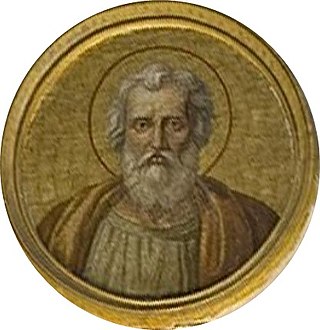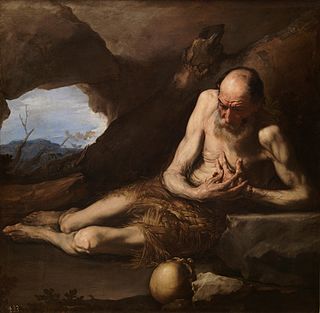Related Research Articles

Antipope Felix was a Roman archdeacon in the 4th century who was installed irregularly in 355 as an antipope and reigned until 365 after Emperor Constantius II banished the then current pope, Liberius. Constantius, following the refusal of the laity to accept Felix, attempted to have them co-rule, but Felix was forced to retire. He was resented in his lifetime but has enjoyed a more popular memory since.

Benedict of Nursia, often known as Saint Benedict, was an Italian Christian monk, writer, and theologian who is venerated in the Catholic Church, the Eastern Orthodox Church, the Oriental Orthodox Churches, the Anglican Communion, and Old Catholic Churches. He is a patron saint of Europe.

Catherine of Siena, TOSD was an Italian member of the Third Order of Saint Dominic in the Roman Catholic Church. She was a mystic, activist, and author who had a great influence on Italian literature and on the Catholic Church. Canonized in 1461, she is also a Doctor of the Church.
Pope Boniface IV was the bishop of Rome from 608 to his death. Boniface had served as a deacon under Pope Gregory I, and like his mentor, he ran the Lateran Palace as a monastery. As pope, he encouraged monasticism. With imperial permission, he converted the Pantheon into a church. In 610, he conferred with Bishop Mellitus of London regarding the needs of the English Church. He is venerated as a saint in the Catholic Church with a universal feast day on 8 May.

Blaise of Sebaste was a physician and bishop of Sebastea in historical Armenia who is venerated as a Christian saint and martyr.

The Dialogues of Gregory the Great is a collection of four books of miracles, signs, wonders, and healings done by the holy men of sixth-century Italy.

Sep. 15 - Eastern Orthodox liturgical calendar - Sep. 17

September 22 - Eastern Orthodox liturgical calendar - September 24

Roch, also called Rock in English, is a Catholic saint, a confessor whose death is commemorated on 16 August and 9 September in Italy; he is especially invoked against the plague. He has the designation of Rollox in Glasgow, Scotland, said to be a corruption of Roch's Loch, which referred to a small loch once near a chapel dedicated to Roch in 1506.

Paul of Thebes, commonly known as Paul the First Hermit or Paul the Anchorite, was an Egyptian saint regarded as the first Christian hermit, who was claimed to have lived alone in the desert of Thebes, Roman Egypt from the age of sixteen to the age of one hundred and thirteen years old. He was canonized in 491 by Pope Gelasius I, and is venerated as a saint by the Catholic Church, Eastern Orthodox Church, and Oriental Orthodox Churches.

Saint Pantaleon, counted in Western Christianity as among the late-medieval Fourteen Holy Helpers and in Eastern Christianity as one of the Holy Unmercenary Healers, was a martyr of Nicomedia in Bithynia during the Diocletianic Persecution of 305 AD.

Martinian and Processus were Christian martyrs of ancient Rome. Neither the years they lived nor the circumstances of their deaths are known. They are currently buried in St. Peter's Basilica in Rome.

Saints Cyprian and Justina are honored in the Catholic Church, Eastern Orthodox Church and Oriental Orthodoxy as Christians of Antioch, who in 304, during the Diocletianic Persecution, suffered martyrdom at Nicomedia on September 26. According to Roman Catholic sources, no Bishop of Antioch bore the name of Cyprian.

Sabinus of Spoleto was a bishop in the early Christian church who resisted the Diocletianic Persecution and was martyred.
Abundius and Irenaeus were Roman martyrs during the reign of Roman Emperor Valerian (253-260). Their feast in the Roman Martyrology is celebrated on August 26. Abundius also has separate commemorations in Augsburg and Orvieto.

December 3 - Eastern Orthodox liturgical calendar - December 5

December 9 - Eastern Orthodox liturgical calendar - December 11

December 25 – Eastern Orthodox liturgical calendar – December 27

Theodore was a sixth-century sacristan in the Church of St. Peter in Rome. He is mentioned in the writings of Gregory the Great, and was later venerated as a saint.
Acontius is a young man in Greek mythology.
References
- ↑ Holweck, F. G., A Biographical Dictionary of the Saints. St. Louis, MO: B. Herder Book Co. 1924.
- ↑ Jones, Terry. "Abundius the Sacristan". Saints.SQPN.com. Archived from the original on 2011-12-28. Retrieved 2012-02-24.
- ↑ Gregory the Great (1911). "Of Abundius, Keeper of the same Church of St. Peter". In Edmund G. Gardner (ed.). Dialogues. London: Philip Lee Warner.
- ↑ Rabenstein, Katherine (April 1999). "Abundius the Sacristan". Saints O' the Day for April 14. Archived from the original on February 6, 2007. Retrieved 2012-02-24.
- ↑ Confraternity of Ss. Peter & Paul. "April 14". The Roman Martyrology. Archived from the original on 2005-03-10. Retrieved 2007-04-13.